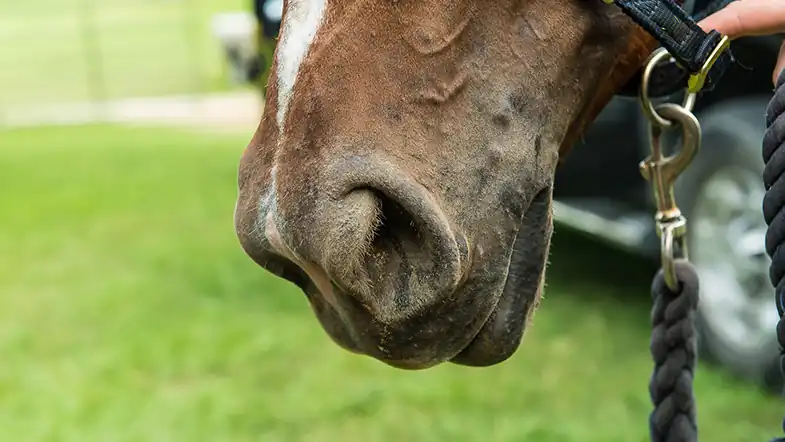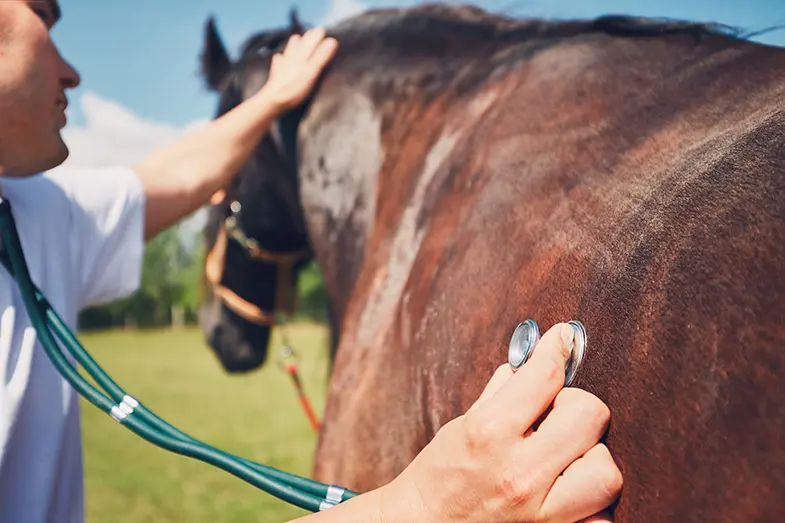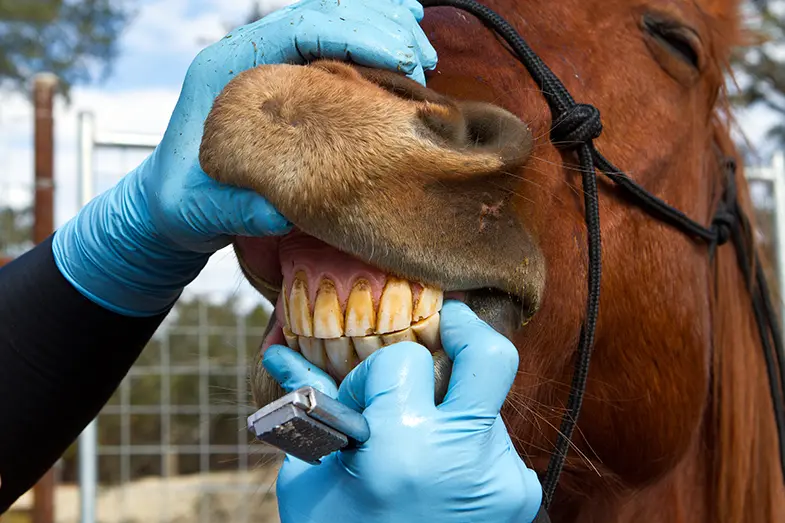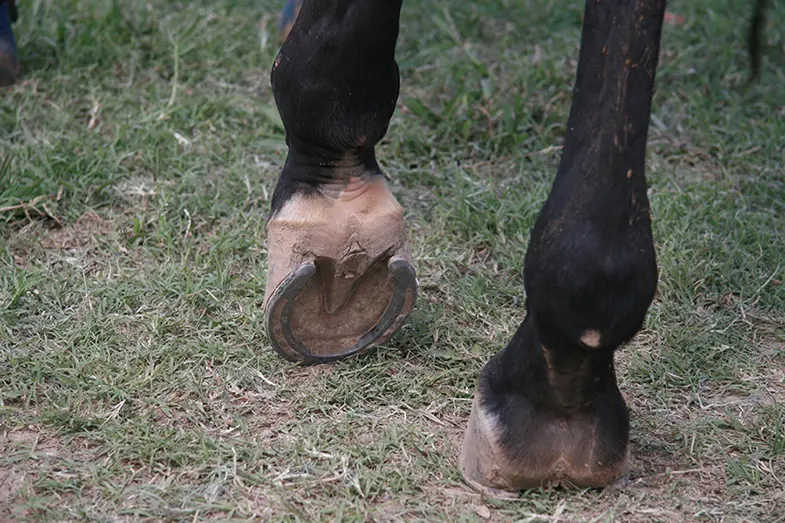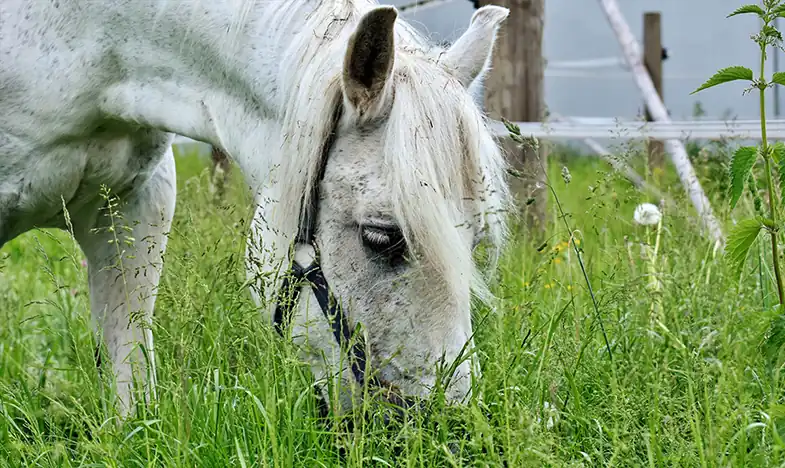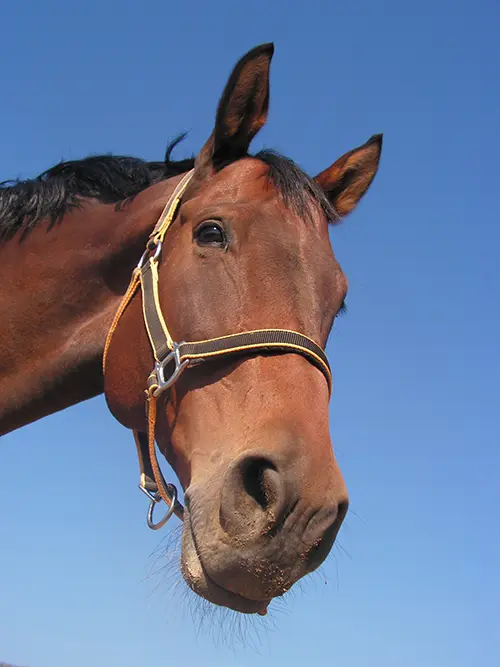If you’re new to horses or have never owned one before it can be daunting at first if you don’t know what to look out for in a healthy horse. Horses can’t tell us when something is wrong and have to rely on us to understand what’s normal and what isn’t which is why I decided to write this article.
How do you tell if a horse is healthy? A healthy horse should have a heart rate of around 38 bpm, a temperature of approximately 37.5°C (99.5°F), and take between 10 and 24 breaths a minute. They should also have a shiny coat, a good appetite, be drinking plenty of water, and have firm droppings.
When a horse is unwell there will be noticeable changes in the behavior as well as physiological changes which makes it much easier to know when something is wrong. That said though, you can’t do this until you know what is normal for a healthy horse and what you need to be on the lookout for.
1) Temperature, pulse and respiration (TPR)
Your horse’s temperature, pulse, and respiration (sometimes referred to as a horse’s vital signs or TPR) are a very good indicator of how your horse is feeling and whether or not he’s healthy or anxious about anything. A change in these can often be the first indication that something is wrong so it’s crucial you know what’s normal for your horse.
If your horse needs medical attention at any point your vet may also need to know what’s normal for your horse so it’s important to know what your horse’s vital signs are. The table below is a guide to what is considered normal (and healthy) for horses.
| Vital Sign | Normal reading for an adult horse |
|---|---|
| Temperature (T) | 37.2-38.5°C / 99-101.3°F |
| Pulse (P) | 24-44 bpm (average 36-40 bpm) |
| Respiration (R) | 10-24 bpm (average 12-16 bpm) |
Temperature
The temperature of a healthy, happy and relaxed horse should be somewhere between 37.2°C and 38.5°C (99°F to 101.3°F), this is considered a normal temperature whereas anything above it is regarded as a fever and anything below is said to be hypothermic. Anything above 39°C (102.2°F) or below 37°C (98.6°F) needs immediate medical attention.
A horse’s temperature will fluctuate a little bit but over time you’ll learn what’s normal for your horse and what’s cause for concern. That said though if you’ve exercised your horse recently it’s better to wait for at least 15 minutes before taking a reading. This will give his temperature time to return to normal.
The best, and most reliable, way of taking your horse’s temperature is to use a digital rectal thermometer. This can sometimes, however, result in a lower than expected reading. If this is the case, and your horse appears to be perfectly healthy (and not cold) then you should walk him around for 5 to 10 minutes before rechecking. This will help to dispel any gas or manure that may have been sitting in the rectum and preventing an accurate reading.
Pulse (or heart rate)
A healthy horse’s pulse or heart rate is normally somewhere between 24 and 44 beats per minute, depending on the weather, but the average horse’s heart will beat from 36 to 40 bpm. This might seem like a very wide range but the reason for this is that there are so many external factors that can play a role in this, for example, younger horses have a higher heart rate compared to older horses. The ambient temperature and humidity as well as a horse’s excitement levels can also affect your horse’s heart rate.
The easiest way to find out what your horse’s heart rate is is to use a stethoscope, which should be positioned on the left-hand side, just behind the elbow (in the girth area). Count the number of beats you hear over a 15 second period and then multiply that by 4 to get your horse’s heart rate. If you don’t have a stethoscope then you can place two fingers just inside your horse’s jaw or on his ankle.
If your horse’s heart rate is above 44 but lower than 60 he could be excited or anxious so it’s advisable to walk him around for a little while and then take it again, or if you’re able to take it again in a few hours. If, on the other hand, it’s over 60 then it’s a sign your horse may be uncomfortable and in pain, so you should speak to your vet for advice.
Respiration
The average horse will take between 12 and 16 breaths a minute but anything from 10 to 24 is okay, but like a horse’s pulse, its respiration rate can change depending on a number of other factors such as how recently a horse was exercised or how cold the weather is.
Again a stethoscope (which should be placed over the trachea which is at the bottom of the neck) is the most reliable way of telling what your horse’s respiration rate is but you can also watch their flank or nostrils move. Some people suggest holding your hand in front of the horse’s nostrils and counting how many breaths you feel but this won’t give an accurate reading because the horse is likely to respond by sniffing the air which will increase the number of breaths he takes. Just as is the case with your horse’s pulse, you should take the number of breaths he takes for 15 seconds then multiply it by 4.
If your horse’s respiration rate is higher than his heart rate then he’s in some sort of physiological distress so you should call your vet immediately.
2) Capillary refill and blood flow
Blood flow helps to carry oxygen and other nutrients around a horse’s body so is vital to their well-being but it can be difficult to see how well their blood is flowing at a glance which is why we use the capillary refill test to gauge this.
The best way of doing this is to firmly press a finger on your horse’s gums for two seconds then quickly release it and count how long it takes for the color to return. The gums of a healthy horse with good blood flow will return to their normal pink color in less than two seconds.
If it takes longer than two seconds it could be a sign your horse is dehydrated, make sure he’s got plenty of fresh water, and try again in a few hours. If it still doesn’t improve after this then you should speak to your vet for medical advice as it could indicate other more serious health problems.
A horse’s gums should be pink in color and look moist, but if they’re not then you should speak to your vet for advice, especially if they are yellow or deep red in color or have small, streaky broken blood vessels.
3) Mucous membrane and hydration
Proper hydration is crucial to a horse’s well being but it can be difficult to know exactly how much water your horse needs, let alone know how much he’s actually drinking which is why we have to look for other signs as to whether or not they’re hydrated.
There are two ways of telling if a horse is drinking and it’s better to use both methods to be sure.
Mucous membrane
The mucous membrane is a tissue that lines a horse’s body and secretes mucus but this can most clearly be seen in the horse’s gums. Horses that are hydrated will have moist, shiny gums that have a salmony pink color. If they’re pale in color or feel tacky or sticky to the touch then your horse is dehydrated.
Skin pinch test
You can quickly check if a horse is hydrated or not by pinching a fold of skin at the base of their neck (near the shoulder) then, after a couple of seconds, letting it go and counting how long it takes to return to normal. Anything under 2 seconds is good but anything over is an indication your horse isn’t drinking enough.
| Time skin takes to return to normal | Hydration level of the horse |
|---|---|
| Immediate | Normal |
| 2-4 seconds | Mildly dehydrated |
| 4-10 seconds | Moderately dehydrated |
| More than 10 seconds | Severely dehydrated |
4) Gut sounds
You might think this is strange but listening to your horse’s gut can tell you if he’s healthy or if he has some sort of digestive issue which might need medical treatment.
You don’t need to use a stethoscope to listen to your horse’s gut but doing so can make it easier to hear and will also prevent other sounds from affecting what you hear. A normal horse’s gut will gurgle or tinkle and will have an occasional roar, there’s no rhythm to their gut but you should hear something every few seconds. If you don’t hear anything at all then it’s a sign your horse has a problem and you should check him for symptoms of colic.
5) Eyes, ears, and nostrils
By paying attention to your horse’s eyes, ears and nostrils you can quickly see if something is amiss.
Eyes
A healthy horse, without any eye conditions, should have clear, bright eyes that are fully open and free of discharge. If your horse’s eyes (or just one of them) are dull or cloudy, or he keeps bumping into things then it could indicate he has a problem with his vision but your vet will be able to confirm this.
If your horse squints with one eye when he’s in the light, or if the eye is swollen and has discharge (especially around the socket) you should speak to your vet for advice.
Ears
Horses are naturally curious animals which is evident if you’ve ever watched a horse swiveling their ears around, but if your horse is unwell he won’t be so alert to everything going on around him. While you can’t tell how a horse is feeling just by looking at his ears it is a good barometer. For example, if a horse is healthy his ears are alert and fully mobile, if he’s relaxed (or bored) they can droop to the side whereas if they’re pinned back he may be angry, but could just as easily be in pain.
Nostrils
Some horses can have a little bit of clear discharge from their nostrils but this isn’t anything to worry about, if the discharge is excessive or discolored though it’s a sign something is wrong. Some infectious viruses, such as equine flu, can cause discharge in the nostrils so you should isolate your horse and call the vet immediately.
6) Teeth
While your horse’s teeth are extremely important to his well-being it’s more that having problems with them can negatively impact his health rather than his teeth are an indication of his overall health. Like most grazers, horses’ teeth continually grow so need to be checked regularly and monitored.
You should check your horse’s teeth for sharp points that can develop over time as well as for uneven wear but you should also lookout for signs that your horse is having problems with his teeth. Some horses that have teeth issues will turn their head to one side and may slobber or dribble food out of their mouth. If your horse drops a lot of his food out of his mouth when he’s eating then his teeth may be causing him pain, if this is the case you should speak to your vet or equine dentist for advice.
Most horses need to have their teeth checked and floated once a year but older horses, or those with persistent issues, may need to have them checked more frequently, especially if they’re having trouble chewing.
7) Hooves and coat
You might not realize it but your horse’s hooves and coat can tell you a lot about how they’re feeling as well as whether or not they’re getting enough of the right nutrients, just as you can with our hair and nails.
Hooves
While the weather (especially when it’s wet) can play a part in the appearance and condition of your horse’s hooves, so can their diet. A healthy horse that’s getting all of the vitamins and minerals they need will have round, smooth hooves with no cracks or missing sections, although a few chips are normal. The wall of the hoof should grow approximately a quarter to half an inch a month, with the new growth being straight when viewed from the side. The frog should also be supple and flexible and there should be no smell or discharge from the hoof at all.
If your horse’s hooves are dry, brittle, and cracked, or are excessively long you should speak to your farrier and ask him for advice. In most cases, they will just need trimming but it could also be a sign of your horse lacking some nutrition.
If one of your horse’s hooves (or multiple hooves) have a foul smell and have any sort of discharge you should check to make sure they don’t have anything stuck in them or that your horse doesn’t have any injuries. It’s also a good idea to speak to your vet because your horse’s hoof may be infected.
Regardless of whether or not your horse needs shoes, you should arrange for your farrier to check (and if necessary trim) them regularly.
Coat
The quality of your horse’s coat will depend on his age (older horses tend to have longer coarser coats), but as a general rule, a healthy horse will have a soft, shiny coat during the summer and a longer, thicker coat during the winter that doesn’t have quite as much shine.
A shiny, glossy coat is a sign that the horse is healthy and well looked after because regular grooming will help to bring the shine out. That said though how much your horse’s coat shines will, to some extent, depend on his color, for example, a chestnut horse will have a much shinier coat than a buckskin one.
A dull coat can be an indication your horse is lacking some nutrients, is in poor general health, or has a problem with parasites such as worms.
Most horses will start to shed their winter coats in the spring but if this doesn’t happen, and the temperature has started to warm up, then your horse can have underlying health problems. Likewise, if your horse’s coat is curlier than normal then it could be a sign your horse has Cushing’s so you should speak to your vet.
8) Legs and movement
It’s important to know your horse’s legs and what’s normal for them, your horse may have cold splints, old injuries, or unique bumps that will feel different to the touch. By knowing what’s normal for your horse you’ll be able to tell when something is wrong.
Legs
Healthy legs should be clean and free of lumps and bumps (aside from what’s normal for your horse) and he should be able to stand squarely with his weight evenly distributed over each of his legs. Taking the weight off of a hind leg is perfectly normal, but doing so with a front leg isn’t.
The best way of checking your horse’s legs is to do it when you’re grooming him. Making it part of your daily grooming routine will ensure you notice anything that’s wrong straight away. You should give them a general check over but particularly lookout for signs of heat or swelling as well as any cuts or lumps.
Movement
When it comes to how your horse moves, he should be able to move freely with flowing movements and not show any signs of lameness or have an abnormal gait. A horse that’s lame will appear to have a shorter step than normal and may even nod their head when they’re trotted on hard surfaces.
If you suspect your horse may be suffering lameness then you should speak to your vet for advice. There can be many reasons why a horse is lame and they’ll be able to give you a proper diagnosis as well as a treatment plan. You may also find this article helpful.
9) Body condition
A horse’s overall condition is a good way of telling how a horse is feeling and whether something is wrong or not but part of that is understanding your horse’s weight and what his body conditions score is.
It’s important to understand what your horse’s optimum weight is and to try and maintain it as much as possible. Horses can lose and gain weight quickly so you’ll probably need to adjust his food throughout the year, especially if he’s grazing a lot.
All horses are different which can make it difficult to know whether or not your horse is a healthy weight or not but as a rough guide you should be able to feel his ribs but not be able to see them. To help understand and access a horse’s condition Dr. Henneke developed a scoring system which today is the best way of assessing a horse’s overall well-being. Based on a scoring system of 1 to 9 (with 4 and 5 being the ideal score), the system, which is known as the Henneke Body Condition Scoring System, helps to determine if a horse is too thin or too fat or at its optimum condition.
10) Appetite
Horses are continual grazers and should have a good appetite, they should also be excited at feeding time and hurry towards their food. With this in mind, you should pay close attention to your horse’s eating habits. If your horse has lost his appetite, isn’t eating as much as normal, or is refusing to eat completely then something is definitely wrong but there can be a couple of reasons for this.
If your horse is refusing to eat he could be suffering from an infectious disease such as equine flu or West Nile virus (which can be carried by mosquitoes. A refusal to eat could also be an indication of a problem with his teeth but checking his temperature can help you to differentiate between a health problem or a dental one – anything above normal could indicate an infection.
11) Manure and urine
While manure and urine are obviously waste products they can still tell you a lot about how a horse is feeling, from their digestive system to how hydrated they are. They can also help to tell you how your horse is feeling, emotionally.
Manure
A healthy horse will produce well-formed, form balls of manure that are free from big chunks of undigested food. They should also be uniform in color and have a subtle smell but contain no mucus at all. Most healthy horses will defecate approximately 8 to 12 times a day.
If your horse’s droppings are loose and watery then he could be stressed or nervous or it could be that he’s suffering from a digestive tract infection. If, however, there are chunks of undigested food then it could be his gut isn’t able to break the food down properly and therefore isn’t getting the nutrients he needs.
Urine
If your horse is healthy and drinking enough water then their urine should be a yellowy tan color (similar to the color of wheat) and be either clear or slightly cloudy. They should also urinate around 7 to 10 times a day, although this can increase for mares that are in heat.
Urine that’s dark brown or red in color could be a sign of an internal illness or of organ strain so you should speak to your vet immediately. You should also ask your vet for advice if your horse stretches a lot as if they’re going to urinate but don’t actually go. This could be a sign that your horse is in discomfort and is always best to get checked.
12) Behaviour
Horses are social animals that are naturally curious and interested in their surroundings as well as in other horses which can be a good barometer of how a horse is feeling. If they’re bright and alert and paying attention to what’s going on around them then chances are everything is okay. Sick horses or those that are injured or uncomfortable may appear dull, listless, and uninterested in their surroundings.
Being herd animals horses that are outside will spend a lot of their time eating and bonding with the same group of horses, but if your horse has started to move away from the herd (and not moved into another group) then it’s a sign something is wrong.
If your horse is in pain then his behavior may also change and you should look out for signs of this. Things such as rolling, pawing, repeated kicking (of their stomachs or just thin air), or rapid breathing can all indicate pain so should be investigated by your vet.
Some horses will paw or stomp at the ground if they’re bored or suffering from flies so if your horse is doing this with no other symptoms you should make sure he’s not being pestered by flies and isn’t bored.
What should you look out for in an unhealthy horse?
Not all horses will display all symptoms but as a quick reference you should be looking out for at least one of the following:
- Stretching out with their legs instead of standing square
- Leaning back on hind legs, as if they’re sitting down
- Constantly shifting their weight from one leg to another
- Not putting any weight on one leg in particular
- Lying down but not wanting to get back up
- Lying down a lot more than normal
- Repeated pawing or stomping at the ground
- Trying to bite of kick their own stomach
- Rolling but not shaking when they get back up
- Walking round in circles or pacing up and down
- Lack of coordination or bumping into things
- Standing with a low head and being uninterested
- Excessive sweating with no obvious reason
- Separating themselves from the rest of the herd
Shop the article
You don’t really need to buy anything special to check your horse’s health but you do need a rectal thermometer which you can easily buy on Amazon. You may find it easier to listen to your horse’s heart, breathing and gut sounds with a stethoscope but this isn’t necessary if you’d prefer not to use one. If you do want to use one though then the best price I’ve seen is also on Amazon.
Further reading
- How can you tell if your horse is cold?
- Can horses cope with being in the rain?
- How to warm up a horse that’s cold
- How to keep a horse cool in the summer
- How often should you wash your horse?
- Dos and don’t of feeding before riding
- Why horses are happier living outside
- How do you care for a blind horse?
- Why do horses foam at the mouth?
- Natural remedies for common aliments
I hope you found this article helpful. If you did I’d be grateful if you could share it please as it would really help me.
Recommended products
Over the years I have tried hundreds of different horsey products, from various blankets and halters to different treats. Some I’ve loved, others I’ve hated but I thought I’d share with you my top all-time favorite products, the ones I never leave the yard without. I’ve included links to the products (which are in no particular order) that I really think are great.
- Horse Knots by Reference Ready – If you’re like me and enjoy pocket reference guides then you’ll love this knot tying guide. These handy cards can easily fit in your pocket or attach to the saddle for quick reference. They’re waterproof, durable and are color coded to make them easy to follow.
- Mane ’n Tail Detangler – Even if you never show your horse you’ll need to detangle his tail from time to time (and possibly his mane too) which is always a challenging chore! I’ve found that if I run a little bit of detangler through my horse’s tails every few days it stops them from getting matted up and makes combing them easy, even if they’re coated in mud. I don’t know if I should admit to this or not but it also works wonders on my hair.
- TAKEKIT Pro clippers – Over the years I’ve tried a lot of different clippers and while some were obviously better than others I found these to be by far the best. They are heavier than a lot of other clippers but for me, that’s a good thing, it makes them feel more sturdy and hardwearing. On top of that they have a range of speeds so are just as good for clipping your horse’s back as they are his face. I also like the fact that they come in a handy carry case but that’s not for everybody. The company that makes them is super good and incredibly helpful too, a real bonus these days. The only thing I wasn’t keen on was the fact that it doesn’t come with any oil, but that’s not a major problem as it’s not difficult to buy lubricant.
- Shire’s ball feeder – There are so many boredom buster toys out there but I like to use these every day, regardless of whether or not my horses are bored. I find that it helps to encourage my horses to problem solve by rewarding them with treats (or pieces of fruit) but it also mimics their natural grazing behavior which helps to keep them calm and de-stressed.
- Horse safe mirror – This is a strange one that many people are surprised about but I like to put horse safe mirrors in the trailers as well as in the quarantine stalls. It helps to prevent the feeling of isolation by giving the impression of other horses being around. Being herd animals horses can get extremely stressed when they feel that they’re on their own but with these stick-on mirrors, they believe that at least one other horse is with them.
- Rectal thermometer – I know this isn’t glamourous at all but it’s vital for your horse’s well-being to be able to check their temperature and a rectal thermometer is the easiest way of doing this which is why I’ve added it to the list.
Shopping lists
I’ve also put together a few shopping lists of essential items that I’ve found helpful over the years. I’ve broken the lists down into different categories rather than put everything in one massive list 😉

